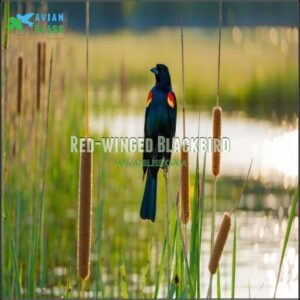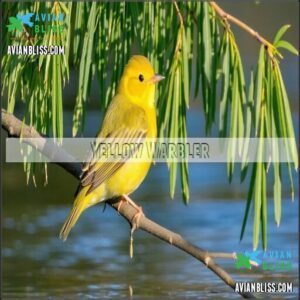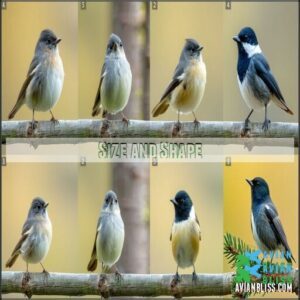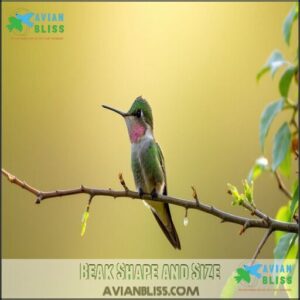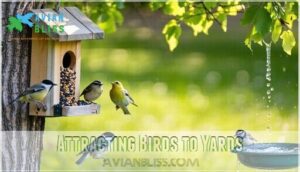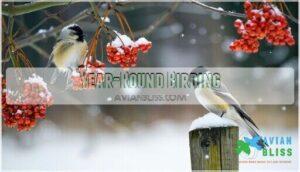This site is supported by our readers. We may earn a commission, at no cost to you, if you purchase through links.
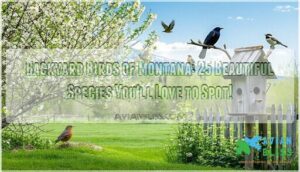
Northern Flickers drum on wood, while European Starlings chatter in flocks. Red-winged Blackbirds add a splash of red to wetlands, and House Finches brighten feeders with their rosy hues.
Keep an eye out for Western Meadowlarks, Montana’s state bird, singing their sweet melody. To attract these beauties, provide seed-filled feeders, fresh water, and native plants. Curious which birds visit in winter? Stick around for seasonal tips!
Table Of Contents
- Key Takeaways
- Montana Backyard Birds
- Common Bird Species
- Bird Identification Tips
- Attracting Birds to Yards
- Year-Round Birding
- Frequently Asked Questions (FAQs)
- What are the most common backyard birds in Montana?
- What birds can you see in Montana?
- How many bird species are in Montana?
- Do you see birds at feeders in Montana?
- Is Montana a good state for birding?
- What is the largest bird in Montana?
- How do I identify a bird in my backyard?
- What kind of birds are in Montana?
- What is the GREY bird in Montana?
- Which birds are found around your house?
- Conclusion
Key Takeaways
- You’ll spot year-round favorites like Black-capped Chickadees, American Robins, and Northern Flickers, along with seasonal visitors like Yellow Warblers and Western Meadowlarks.
- Attract more birds by offering seed-filled feeders, fresh water, and native plants, while avoiding pesticides and providing birdhouses for nesting and shelter.
- Pay attention to size, shape, color patterns, and behaviors like feeding habits to identify birds in your backyard.
- Migration patterns and seasonal behaviors, like nesting in summer or flock feeding in winter, show how Montana’s birds adapt to changing conditions.
Montana Backyard Birds
You’ll find Montana’s yards and gardens host a remarkable variety of birds, from the state bird Western Meadowlark to year-round residents like Black-capped Chickadees and Northern Flickers.
Montana’s backyards brim with birdlife, from the vibrant Western Meadowlark to cheerful Black-capped Chickadees and striking Northern Flickers.
With 429 recorded species in the state, you’re bound to spot familiar favorites like American Robins alongside distinctive visitors such as Red-winged Blackbirds with their scarlet shoulder patches.
American Robin
Spotting an American Robin in your Montana backyard is a common yet delightful experience.
You’ll recognize this year-round resident by its dark gray back and brick-red belly.
Robins prefer open lawns where they hunt for worms and insects.
Their cheerful "cheerily, cheer up" song announces spring’s arrival.
During migration, they often gather in flocks before settling down to build their distinctive mud-cup nests.
Black-billed Magpie
The Black-billed Magpie stands out in your Montana backyard with its striking black-and-white pattern and impressively long tail.
A bold entertainer, the Black-billed Magpie dazzles with its striking plumage, long tail, and curious antics in Montana backyards.
These intelligent corvids build large, bushel-basket nests in nearby trees and often gather in noisy flocks.
You’ll love watching these birds because:
- Their bold personality and curious behavior provide endless entertainment
- Their glossy black feathers shine with purple and green iridescence in sunlight
- Their distinctive "mag-mag-mag" vocalizations announce their presence throughout the day
They are also known for their opportunistic omnivorous diet, consuming everything from insects to carrion, which showcases their intelligent and opportunistic nature, making them a fascinating bird to observe with their striking appearance.
Black-capped Chickadee
While magpies command attention with their size, you’ll find the Black-capped Chickadee brings cheerful energy to Montana yards year-round.
These tiny birds with black caps and white cheeks are easily recognized by their "chick-a-dee-dee" calls.
They’re curious and bold, often the first to investigate new bird feeders. You’ll spot them darting between trees, searching for insects and seeds in both summer and winter.
Northern Flicker
Just as chickadees bring charm with their tiny size, the Northern Flicker delivers drama to your Montana backyard.
This fairly large, tan and gray woodpecker sports distinctive barring on its back and a black breast mark.
Northern Flickers in Montana can be identified by:
- Their unique ground-feeding habit unlike other woodpeckers
- Bright yellow underwing flashes during flight
- Distinctive "wicka-wicka-wicka" calls
- Red or yellow shafts depending on region
- Round black spots on their belly
The combination of these characteristics makes the Northern Flicker a notable visitor to any Montana backyard.
European Starling
The glossy-coated European Starling, an introduced species, can be found year-round in Montana’s backyards.
You’ll spot these plump, short-tailed birds with sharp beaks in various plumages throughout the seasons. They’re common visitors, appearing in 28% of summer and 14% of winter checklists.
| Starling Feature | Description | Identification Tip |
|---|---|---|
| Size | Medium (8-9 inches) | Chunky body, shorter tail |
| Color | Glossy black with iridescence | Purple-green sheen visible in sunlight |
| Beak | Yellow (breeding), dark (winter) | Sharp and pointed |
| Habitat | Urban areas, fields, backyards | Often in large, noisy flocks |
| Diet | Insects, fruits, seeds, human food | Aggressive feeders at bird tables |
They are known for their aggressive feeding behavior at bird tables, making them a notable presence in backyards.
Common Bird Species
You’ll spot several familiar species in Montana’s diverse habitats, with the Red-winged Blackbird‘s distinctive shoulder patches and the Western Meadowlark’s yellow breast being common sights year-round.
Montana’s 429 recorded bird species include colorful visitors like the Yellow Warbler and adaptable residents such as the House Finch, making your backyard a perfect observation point.
Red-winged Blackbird
A striking sight in Montana wetlands, the Red-winged Blackbird (Agelaius phoeniceus) will capture your attention with its bold appearance.
You’ll recognize males by their glossy black bodies and distinctive red shoulder patches bordered with yellow.
When identifying these backyard birds, look for:
- Male plumage featuring jet-black feathers and bright red-yellow epaulets
- Female appearance with brown streaking and subdued coloring
- Habitat preference for marshes, wet meadows, and cattails
- Vocalizations consisting of a characteristic "conk-la-ree" call
House Finch
While Red-winged Blackbirds announce their presence boldly, House Finches (Haemorhous mexicanus) offer a more subtle beauty in Montana yards.
You’ll recognize males by their rosy red heads and breasts, while females sport streaky brown patterns.
These adaptable finches love sunflower seeds at your bird feeders.
Originally desert dwellers, they’ve expanded across Montana, often building nests near homes, and you can listen for their warbling song—a cheerful soundtrack to your backyard birding adventures.
Western Meadowlark
Montana’s State Bird, the Western Meadowlark, stands out in open grasslands with its vibrant yellow breast and distinctive black collar.
You’ll recognize this grassland songbird by its chunky build (about 8.5 inches long) and melodious meadowlark song that carries across fields.
They prefer natural grasslands for habitat preferences and probe the ground with their long, pointed bills searching for insects.
Despite population declines, these beautiful backyard birds remain a common sight throughout Montana.
They’re also experiencing significant habitat loss, impacting their food options and contributing to population declines in a common sight.
Yellow Warbler
The Yellow Warbler brings a splash of sunshine to Montana’s landscape.
You’ll spot this small yellow bird with its sharp beak flitting through shrubs and trees near water sources.
Males display bright yellow plumage with reddish-brown streaks on their chest.
Their sweet "sweet-sweet-sweet-sweeter" song is unmistakable.
These songbirds prefer willows and cottonwoods for their breeding habits, building cup-shaped nests while feeding primarily on insects.
Conservation status remains relatively stable across their Montana habitat, with these birds being a key part of the ecosystem.
Yellow-rumped Warbler
While Yellow Warblers bring bright summer color, their cousins the Yellow-rumped Warblers offer year-round delight.
You’ll recognize these small, blue-gray songbirds by their distinctive yellow rump patch. Montana hosts both Audubon’s subspecies (with yellow throat) and Myrtle subspecies (with white throat), which sometimes show hybridization.
They’re more adaptable than other warblers, with a varied diet including insects and berries. Their stable conservation status makes them reliable backyard birds for beginning bird identification enthusiasts.
Bird Identification Tips
You’ll spot Montana’s diverse bird species more easily when you focus on their size, shape, color patterns, and behaviors in their natural habitats.
Identifying key features like beak shape and seasonal plumage changes will transform your backyard birding experience from casual observation to confident recognition.
Size and Shape
Now that you’ve learned about common Montana bird species, let’s focus on how size and shape help with identification.
When observing backyard birds, noting their proportions gives you important clues:
- Relative size compared to familiar birds (sparrow, robin, crow)
- Body proportions (chunky, slender, compact)
- Tail length (short, medium, long)
- Wing shape (pointed, rounded, broad)
- Bill size and structure (short/thick, long/thin, hooked)
These features often remain visible even when colors aren’t clear, making backyard birds and their proportions crucial for identification.
Color Pattern
After noting a bird’s size and shape, focus on its color pattern.
Montana birds showcase distinctive plumage variation that helps with identification.
Look for bold markings like the Red-winged Blackbird’s scarlet shoulders or subtle color camouflage that helps birds blend with their surroundings.
Seasonal molting changes appearances throughout the year, while iridescent feathers on species like the Black-billed Magpie shimmer in sunlight.
Regional differences in backyard birds’ color patterns can indicate specific subspecies.
Behavior and Habitat
Beyond color patterns, a bird’s behavior and habitat provide essential identification clues.
Watch for these distinctive traits in Montana’s backyard birds:
- Where they forage—ground-level seed hunters like Western Meadowlarks versus tree-dwelling insect seekers
- Social structures—solitary hunters or flocking species
- Nesting habits—cavity nesters like Northern Flickers or open-cup builders
- Movement patterns—hopping robins versus walking blackbirds
Montana birds reveal their identity through these behavioral signatures in their natural habitats, which include distinctive traits such as foraging habits and social structures, making them easier to identify through their natural habitats.
Beak Shape and Size
After observing your bird’s movement patterns, look closely at its beak shape and size.
A bird’s beak offers major identification clues and reveals its feeding styles, such as seed-eaters like Montana’s House Finch having short, thick beaks.
While insect-hunters sport thinner ones, Woodpeckers’ chisel-like beaks help them drill trees, each beak shape representing an adaptation to specific food sources.
Making identification of backyard birds much easier is the key, as each beak shape represents a unique adaptation.
Plumage and Molting
Just as beaks tell a bird’s feeding habits, plumage reveals its identity and life stage.
Montana’s backyard birds change their feathers through molting—a process where worn feathers are replaced with fresh ones.
You’ll notice seasonal plumage variations, with many species sporting brighter colors during breeding season. Juvenile plumage often appears speckled or streaked compared to adults.
Watch for these differences in feather types when identifying your Montana wildlife visitors.
Attracting Birds to Yards
You’ll transform your Montana yard into a bird sanctuary by providing the right combination of food, water, shelter, and native plants.
With strategic placement of feeders containing black oil sunflower seeds and suet, plus a reliable water source, you’ll soon attract diverse species from chickadees and nuthatches to woodpeckers and finches.
Bird Feeders and Seed Types
Five types of bird feeders can transform your Montana backyard into a bird haven.
Tube feeders with black oil sunflower seeds attract chickadees and woodpeckers, while ground feeders with millet bring in sparrows and juncos.
Platform feeders, suet feeders, and pinecone DIY feeders each attract different species.
Remember proper feeder placement and hygiene to keep your backyard birds healthy and happy.
Many enjoy providing quality seeds for the birds, such as those found at providing quality seeds.
Providing Water Sources
Water draws Montana backyard birds just as much as feeders do, especially in our dry climate.
Create a bird oasis with:
- Bird bath types ranging from simple dishes to heated winter options
- Multiple water sources placed at different heights (ground level for robins, elevated for chickadees)
- Clean water refreshed every 1-2 days to prevent disease
Attract more birds by providing various bird bath options.
Montana’s ornithology enthusiasts know that fresh water guarantees year-round bird watching enjoyment.
Offering Birdhouses and Shelters
During nesting season, providing proper birdhouses gives Montana’s backyard birds safe places to raise their young.
Choose birdhouses made from natural materials like cedar or pine, with appropriate shelter size for your target species.
For durable housing, consider cedar birdhouse options.
Guarantee predator protection through metal entrance guards and proper placement tips—mount boxes away from branches where predators can jump.
In winter, these structures serve as cozy roosts, protecting birds from harsh Montana weather, and provide them proper shelter.
Creating Bird-Friendly Landscapes
Creating a bird-friendly landscape in your backyard is about more than just feeders.
Plant native species like elderberry and viburnum to provide natural bird food and shelter.
Add layers of vegetation with ground cover, shrubs, and trees of varying heights to mimic natural ecosystems.
Include water features near protective cover and create brush piles from fallen limbs to offer safe havens and nesting sites for your backyard birds.
Avoiding Pesticides and Predators
Your beautiful bird-friendly landscape will attract more feathered visitors when you minimize threats.
Avoid chemical pesticides that can harm backyard birds directly and eliminate their food sources. Instead, try natural pest control methods like companion planting or insect-repelling herbs.
Watch for predator threats too—position bird houses away from places where cats might hide, and install predator deterrents like baffles on feeder poles to keep your native species safe.
Year-Round Birding
You’ll find Montana offers excellent bird watching opportunities throughout all seasons, with resident species like Black-capped Chickadees and Northern Flickers visible year-round.
You can observe different bird behaviors as the seasons change, from the breeding displays of Western Meadowlarks in summer to the feeding frenzies of Black-billed Magpies at winter feeders.
Summer Bird Species
Now that your yard is ready for visitors, Montana’s summer brings an explosion of bird activity.
During breeding season, you’ll notice different nesting habits as backyard birds raise their young.
- American Robins become more territorial, defending their bright blue eggs
- Western Meadowlarks fill mornings with their flute-like songs
- Songbirds of Montana switch to protein-rich summer diets for chick development
- Native species like Yellow Warblers build nests in low shrubs
- Habitat changes include more birds bathing to beat the heat
The presence of these birds and their unique behaviors, such as breeding season habits, make for a fascinating observation experience in your yard.
Winter Bird Species
While snowdrifts pile high, your feeders become lifelines in Montana’s winter habitats.
Common Redpolls and Snow Buntings—northern winter visitors—cleverly burrow into snow during extreme weather. Black-capped Chickadees, American Robins, and Black-billed Magpies remain year-round, developing remarkable cold adaptations to survive food scarcity.
You’ll spot Mountain Chickadees frequenting backyard bird feeders even in deepest winter. European Starlings and Red-winged Blackbirds often form the most commonly counted winter birds in Montana.
The Montana Birding Trail even includes the Roundup River Walk Heritage Trail.
Migration Patterns
Watching birds migrate across Montana’s vast skies reveals nature’s remarkable timing.
American Robins follow the 37-degree isotherm northward, arriving earlier each decade—about five days sooner due to climate impacts.
You’ll notice gender differences too; Red-winged Blackbird males travel before females, while Black-billed Magpies stay put year-round but may wander during breeding season.
Montana ornithology shows Yellow Warblers make impressive night journeys to Mexico, unlike non-migratory House Finches.
Seasonal Bird Behaviors
Seasonal bird behaviors vary widely.
During breeding seasons, backyard birds like robins focus on nest-building, while migration triggers prompt species like warblers to travel.
Winter birds adapt with foraging changes, seeking seeds and suet. Molting patterns often align with these shifts, ensuring fresh plumage for survival.
Photoperiod effects influence these behaviors.
Observing these behaviors reveals how birds thrive through Montana’s seasonal challenges, from summer birds to winter adaptations, and understand the impact of photoperiod effects on their behavior.
Tips for Year-Round Bird Watching
Montana’s weather changes fast, so dress in layers and keep binoculars handy for spotting backyard birds.
Winter birds like chickadees love suet-filled bird feeders, while summer species enjoy seeds.
Ethical birding means respecting habitats and avoiding stress to wildlife.
Keep a journal for data collection—it’s fun and helps with ID challenges.
Bird watching thrives year-round!
Frequently Asked Questions (FAQs)
What are the most common backyard birds in Montana?
You’ll often spot American Robins, Northern Flickers, Black-capped Chickadees, House Finches, and European Starlings in Montana backyards.
These year-round residents thrive with feeders offering seeds, suet, or peanuts, adding lively charm to your space, making them a great addition to any backyard.
What birds can you see in Montana?
You’ll spot birds like the Western Meadowlark, American Robin, Northern Flicker, and Red-winged Blackbird.
Montana’s diverse habitats also host Bald Eagles, House Finches, and Black-billed Magpies, offering year-round birdwatching opportunities for enthusiasts.
How many bird species are in Montana?
You’ll find an impressive 429 bird species recorded in Montana.
From prairies to wetlands, the state’s diverse habitats make it a haven for birdwatchers.
Keep your binoculars handy—you never know what you’ll spot!
Do you see birds at feeders in Montana?
It’s funny how a simple feeder can become a bird magnet in Montana.
You’ll see chickadees, finches, woodpeckers, and even nuthatches flocking to suet, peanuts, or sunflower seeds, especially during winter.
Is Montana a good state for birding?
Montana’s diverse habitats make it a birding paradise.
With prairies, wetlands, and forests, you’ll spot everything from Bald Eagles to Yellow Warblers.
The state’s wide-open spaces offer unmatched opportunities for birdwatching year-round.
What is the largest bird in Montana?
The Bald Eagle holds the title of Montana’s largest bird.
With an impressive wingspan reaching up to 8 feet in females, it’s a majestic sight, symbolizing strength and freedom across the state’s skies.
How do I identify a bird in my backyard?
Think of birds as living puzzles.
Start with size and shape, noting tail length, bill type, and body silhouette.
Add color patterns and behaviors like feeding or perching.
A field guide helps too!
What kind of birds are in Montana?
You’ll find over 400 bird species in Montana, from the vibrant Western Meadowlark to majestic Bald Eagles.
Watch for American Robins, Northern Flickers, and Red-winged Blackbirds, each thriving in the state’s diverse habitats year-round.
What is the GREY bird in Montana?
You might be spotting a Northern Flicker, a tan and gray woodpecker with black barring and a crescent-shaped mark on its chest.
It’s common year-round and often forages on the ground for insects.
Which birds are found around your house?
Around your house in Montana, you’ll often spot American Robins, Black-capped Chickadees, Northern Flickers, and House Finches.
They’re year-round residents, enjoying feeders, trees, and open spaces for nesting, foraging, and singing their cheerful tunes.
Conclusion
Picture a cold winter morning, a Black-capped Chickadee flits to your feeder, its cheerful calls breaking the silence.
Montana’s backyard birds bring life to every season, whether it’s the vibrant Western Meadowlark in spring or the hardy Northern Flicker in winter.
By offering seed-filled feeders, fresh water, and native plants, you’ll create a haven for these feathered visitors.
Observing the backyard birds of Montana isn’t just a hobby—it’s a chance to connect with nature every day, and experience the beauty of these creatures.

